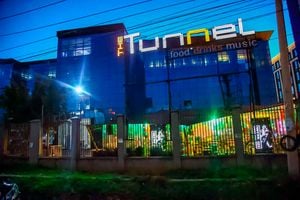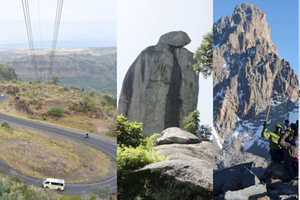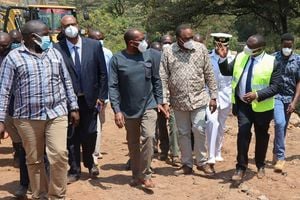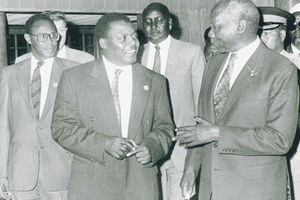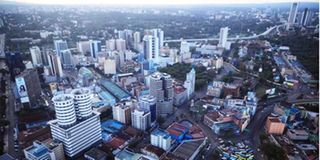
An aerial shot of a section of Nairobi. Many buildings and structures have come up, destroying the city’s original plan of independence Kenya.
Waigwa Kiboi, 72 and Frank Esilaba, 70, have fond memories of a beautiful budding city- sparsely populated, organised public transport, well-planned council estates, few high-rise buildings and dashing greenery.
And the beauty of Nairobi was made even the more spectacular by breathtaking landmarks around it.
Adjacent to the scenic eastern edge of the Rift Valley, bordering the rolling Ngong Hills to the west, the snowcapped Mount Kenya to the north and Mount Kilimanjaro to the south-east, Nairobi was hailed as the ‘Green City in the Sun.’
“I used to live in South C in the 70s. Nairobi in the 70s and 80s was so beautiful although with a few buildings,” reminisces Mr Esilaba, who explains he first came to study in the city shortly after independence in 1963.
“Kenya Railways used to be a beautiful place filled with greenery,” recalls the bishop, referring to a landmark address inter-twined with the city’s history.
Nairobi was founded in 1899 by colonial authorities in British East Africa as a rail depot on the Uganda - Kenya Railway. The previous year, a young assistant railway engineer-Arthur Frederick Church, 30, had been tasked to draw a town plan for the railway depot.
Chief engineer George Whitehouse approved the first town plan on November 30, 1898 and dispatched it to London for final approval. But prior to approval, The white House had changed the spelling of the town from Nyrobi to Nairobi. Nyrobi in Maasai meant a place of cool waters.
After independence in 1963, Nairobi became the capital of the new republic.
“I recall the first grand estate to be put up was Kariobangi South. Buruburu and Umoja came up much later,” bishop Esilaba continues.
“When I came to Nairobi to continue my work, I first lived in Eastleigh and later moved to Pangani,” says Waigwa, who had been employed in the Labour ministry in 1978.
“Most places where matatus used to operate were Eastlands, Makadara and the like, but in the other estates you wouldn’t find a matatu. We had Kenya Bus Services (KBS) buses that were operating across the city estates. There was discipline on the road,” Mr Esilaba recollects.
“We referred to KBS as municipality buses because they were government-owned. We would pay Sh1 from Pangani to Community,” adds Mr Waigwa who resigned from his government job after two years to begin writing for Drum magazine.
And life in the city wasn’t pricey back in the days.
“Life was not expensive, but people would still complain about the cost of living. We used to pay rent at between Sh300 and Sh350 per month for a single room,” says Mr Waigwa.
He was paid a salary of Sh520 before tax in his first government job at National Youth Service in Gilgil in 1974.
“I would pay electricity Sh10,” adds Mr Waigwa who first toured Nairobi as a primary school pupil in the 60s when the likes of Hilton Hotel were under construction.
He returned to Nairobi in 1978- two months to President Jomo Kenyatta’s death- as a Labour ministry employee, earning Sh1,000 monthly. His PS earned Sh9,000.
“We had buildings like Hilton which I had already seen in my younger days being built but when I came back as an adult it was already completed. My cousin invited me to the hotel for a cup of coffee. At the time they had offers, you paid Sh2.50,” he remembers with a chuckle.
But just when and how did things begin to go wrong?
It started with authorities discarding plans that had been prepared to respond to expansion of Nairobi including population implosion.
The Metropolitan Growth Strategy of 1973 recommended decentralisation of the industrial centres to the east and northeast of the city, creation of other satellite centres, construction of three main bypasses and decongesting the central business district.
Infrastructure expansion proposed in the Metropolitan Growth Strategy of 1973 stalled. Only construction of city bypasses has been completed and the Nairobi expressway.
Bus Rapid Transit (BRT) along Thika Road started but stalled. It’s envisaged the BRT will extend to Ngong Road and Jogoo Road all the way to Dandora train station. Other recommendations that remain on paper include a new cemetery to ease pressure on the one at Lang’ata that has filled up. Dandora dump site is yet to be relocated and a new solid waste management system that also transforms waste into energy is still on paper.
Also, the rezoning policy of 1979 went against the fundamental recommendations of the metropolitan policy. It advocated a concentrated Central Business District and allowed higher densities of development.
“However, no attempts were made to evaluate and/or improve the urban infrastructure services and utilities often affected by higher densities such as water supply, parking and recreational facilities among others,” according to a report tabled in the county assembly in June, last year.
The county land use policy of 2023 observes that since the rezoning policy of 1979, planning has been based largely on “ad hoc basis not linked to the city’s general plan and dealing with specific aspects of the city’s growth.”
Then the blueprint expected to guide Nairobi’s growth and development up to 2030 (Niuplan 2014-2030).
“Its development was largely driven by the failures of the old plans and the need to plan a livable city incorporating aspects such as infrastructure. The plan identifies challenges facing the city such as uncontrolled urban development, insufficient infrastructure, transport problems, low supply of middle to low income housing and inadequate coordination between relevant organisations,” says the policy.
It seeks to address transportation, governance, environment, land use, human settlements, population, social systems, urban economy and infrastructure.
The plan recognises seven distinct land uses namely residential, commercial, industrial, institutional, recreational, transportation and agricultural.
The city’s expansion as well as population implosion outpaced the established infrastructure leading to a surge in informal settlements and a strain on essential services, says Nairobi County Chief Officer of Urban Planning Patrick Analo.
“Nairobi experienced an influx of rural migrants seeking economic opportunities in the urban hub. The government attempted to accommodate the growing population by establishing housing estates and addressing the housing needs of civil servants. However, rapid urbanisation outpaced these efforts, giving rise to sprawling slums and informal settlements,” explains Analo who is also acting county secretary.
According to Mr Analo, slums started emerging in the 1980s because more people were coming to the city that had superior universities, colleges, hospitals etc.
The 1970s were marked by economic crises and as the situation worsened, the government reluctantly embraced punitive reforms prescribed by global lenders under Structural Adjustment Programmes (SAPs) in the early 1980s.
“The 1980s marked a turning point as SAPs imposed by international financial institutions halted further housing initiatives, exacerbating the city’s housing crisis,” Analo says.
Little was, however, achieved until the 1990s when comprehensive reforms were implemented.
“Around 1990, the World Bank and the International Monetary Fund (IMF) came up with structural adjustment programmes, which stopped further housing by the National Housing Cooperation which was putting up houses in the city.”
“The rolling out of the programme led to more slums and even the city council stopped putting up houses. The few houses were being built by the private sector and they were very expensive. So we had more people going to live in Mathare, Kibera, Korogocho, Mukuru,and Kawangware, and it kept growing as time went by,” Mr Analo explains.
With the proliferation of slums and the politicisation of urban issues, Nairobi’s challenges were further compounded “leading to a decline in its once-pristine image as the Green City in the Sun,” the county official notes.

Nairobi City Skyline on April 27, 2023.
“Poor waste management, lack of adequate access to fresh water, and lack of proper social amenities, are visible in settlements where people live,” he adds.
“You see, with the growth in population, there are so many people who do so many things that lead to a lot of confusion and demand for commodities. Many people became too desperate and turned to a life of crime. Nobody wanted to go back to their rural homes,” Waigwa says.
Bishop Esilaba adds: “Nairobi has lost its glory. When you look at matatu operations, there’s a lack of discipline. Between the 70s and 90s, the police were firm but nowadays they are doing the same things criminals are doing. There’s no one left to keep order.”
“With the coming of bribes, people can do anything as long as they have money,” he regrets.
“I saw Nairobi changing gradually, and as each government came, it had its own way of handling the country,” Mr Waigwa goes on, adding although at first corruption was rare, “with time people started changing.”
“At the time the city used to have suggestion boxes spread out across the city streets. They were strategically positioned to be easily accessible, and they came about because of so many complaints from people about the state of living. They were supposed to be opened, read and publicly addressed. I think the bad out listed the good and the government feared sharing it with the public because of what they could do,” the veteran journalist observes.
“People complain that there was a lot of corruption during Moi’s time, but corruption has always been there, even during Kenyatta’s time. After Kenyatta’s death and Moi took over, the population had already grown and the cost of living went up too. Every regime that came had its own share of corrupt people.”
With rising population, so were demands for development, and the appetite for borrowing grew.
“The problem with borrowing is that not everything is borrowed for the purpose of helping the citizens,” Mr Waigwa says, adding the era of ghost and white elephant projects set in.
“Boda bodas came during President Mwai Kibaki’s time. The only unfortunate thing about boda bodas is the number of accidents they cause,” he observes.
“The freedom of boda boda riders and hawkers in the city has brought a lot of chaos. The war between council askaris, hawkers and business owners requires a lot of planning to avoid conflict,” Mr Waigwa says, noting efforts to designate certain city backstreet as hawking zones hasn’t helped much.
“Now you find rubbish on the roads but back then they were clean,” Esilaba laments.
“Politicians are the ones making not just Nairobi but Kenya to be chaotic because they are not leaders but short term eaters,” the bishop laments.
“There are so many unfinished projects that run back to over a decade ago. Instead of voting for leaders, we vote for politicians and that’s why we are always in a mess.”
According to Mr Analo, the abuse of multi-party politics in 1992 to abet land invasions in the city’s Eastlands hastened the decay.
“When you don’t have proper infrastructure in place, you cannot do proper waste disposal, and subsequently, you have poor public transport, infrastructure, and roads,” argues the county official.
“The problem grew and even extended beyond Nairobi to Mombasa and Nakuru where we also had slums.”
Is there hope to reclaim the lost glory or it’s all gloom?
The county official says “hope remains on the horizon” citing the ambitious urban renewal projects aimed at revitalising the city’s aging infrastructure and addressing the needs of its burgeoning population.
From housing initiatives to transportation upgrades, the government is laying the groundwork for a brighter future for Nairobi and its residents, he adds.
To improve public transport, Mr Analo says completion of the BRT system along Thika Road is a priority.
BRT is to have more commuters using buses to reduce the number of matatus plying the route.
He says a light-railed transit line from city centre to Jommo Kenyatta International Airport is also on the cards.
“There’s a programme also to modernise the commuter-ring from Athi River to the CBD, Ruiru through Dandora to the CBD and Kikuyu to the CBD,” he explains.
The county government is also investing in housing through the urban renewal program.
“It is going to target six of our estates. We want to redevelop some of the oldest estates and look at the issues of schools, police stations, hospitals, public transport, employment centers, markets in those estates and more,” Mr Analo explains.
The county official discloses the plans are at the advanced stage with surveys and designs done.
“We are engaging the residents to make sure their interests are safeguarded, and that they are also guaranteed that once the estates are complete, they will not be displaced,” he adds.
He says Governor Johnson Sakaja has secured support from Korea and national government is investing to upgrade the water system.
As Nairobi grapples with its past and charts a course for the future, one thing is clear: the city’s journey is far from over.


